Abstract
1. When NG-nitro-L-arginine methyl ester (L-NAME, 0.1-10 nmol) or NG-monomethyl-L-arginine (L-NMMA, 10 nmol-1 mumol) was intradermally administered with bradykinin (BK, 3 nmol) into the instep of rat hind-paws, a dose-related suppression of BK-induced hyperalgesia, assessed by the paw-pressure test, was produced. 2. L-Arginine (1 mumol) but not D-arginine (1 mumol) reversed the suppressive effects of L-NAME (10 nmol) and L-NMMA (1 mumol) on BK-induced hyperalgesia. 3. Concomitant intradermal administration of BK (3 nmol) with haemoglobin (1 nmol) significantly suppressed BK-induced hyperalgesia in the paw-pressure test. The BK-induced hyperalgesia was abolished by concomitant intradermal administration of either a guanylate cyclase inhibitor, methylene blue (10 nmol), or LY83583 (1 nmol). In addition, KT5823 (1 nmol) or Rp-8-bromoguanosine-3':5'-cyclic monophosphothioate (Rp-8-Br-cGMPS; 1 nmol), an inhibitor of cyclic GMP-dependent protein kinase, also significantly suppressed BK-induced hyperalgesia. 4. The carrageenin-induced hyperalgesia was significantly attenuated by L-NAME in a dose-dependent manner. 5. L-Arginine (1 mumol), sodium nitroprusside (1 mumol), dibutyryl cyclic GMP (1 mumol) or 8-bromo cyclic GMP (1 mumol) all failed to produce any significant relieving effect on the nociceptive threshold of rodent hind-paws. Concomitant administrations of each agent with a sub-threshold dose (0.1 nmol) of BK induced significant hyperalgesia. 6. Rp-adenosine 3':5'-cyclic monophosphothioate (Rp-cAMPS; 1 nmol), an inhibitor of cyclic AMP-dependent protein kinase, significantly suppressed BK-induced mechanical hyperalgesia. Concomitant administration of forskolin (1 nmol) with 8-bromo cyclic GMP (100 nmol) induced significant hyperalgesia. 7. In the superfusion experiment of a blister base on the instep of rodent hind-paws, intradermally administered BK (3 nmol) significantly increased the outflow of both cyclic GMP and cyclic AMP from the blister base. Concomitant administrations of L-NAME (10 nmol) with BK significantly reduced the BK-induced outflow of cyclic GMP without affecting the cyclic AMP content. 8. These results suggest that the NO-cyclic GMP pathway is involved in the mechanism of BK-induced hyperalgesia, and an activation of both cyclic GMP-and cyclic AMP-second messenger system plays an important role in the production of peripherally induced mechanical hyperalgesia.
Full text
PDF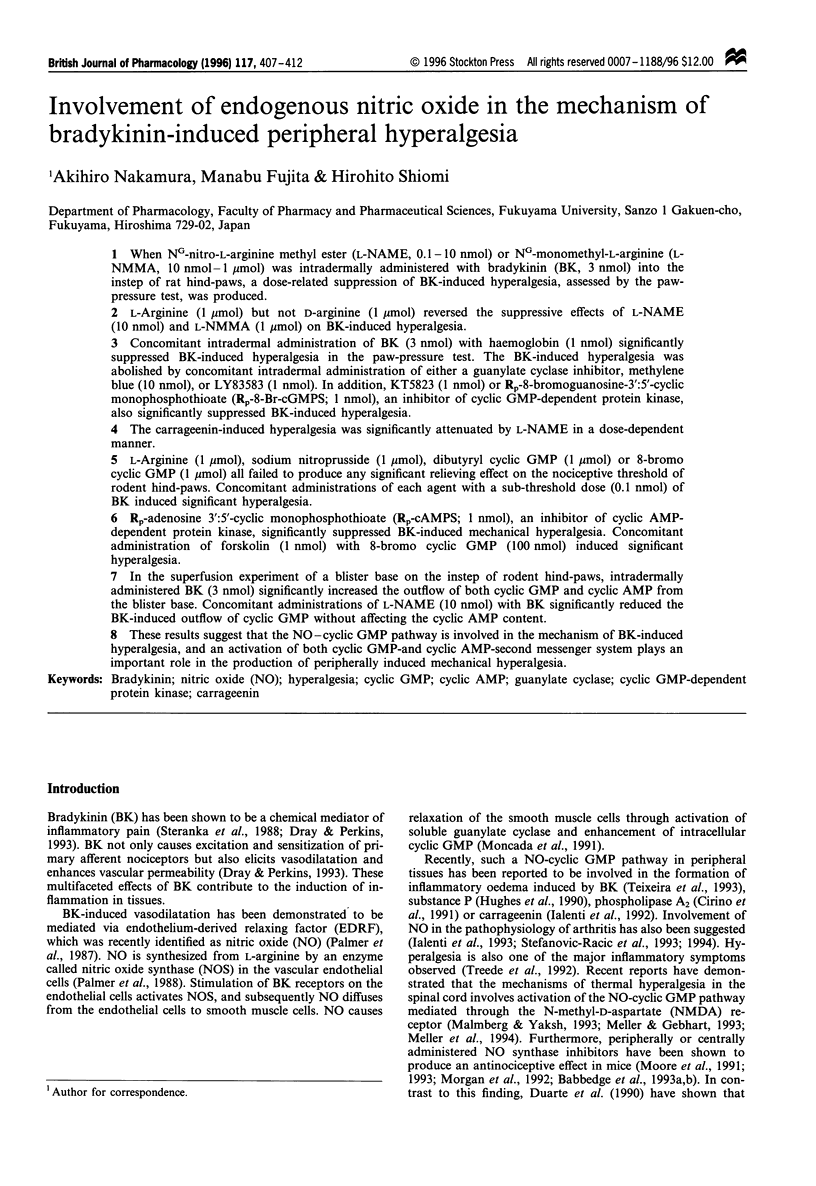
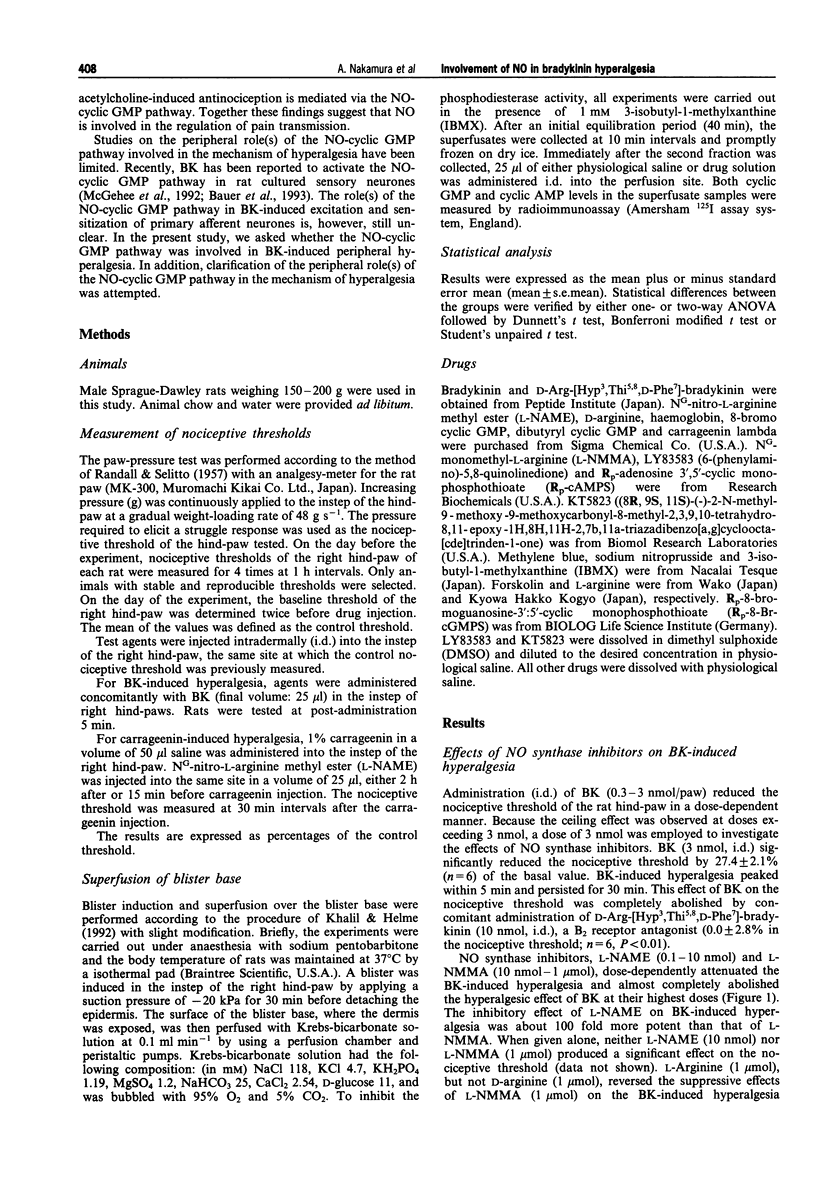
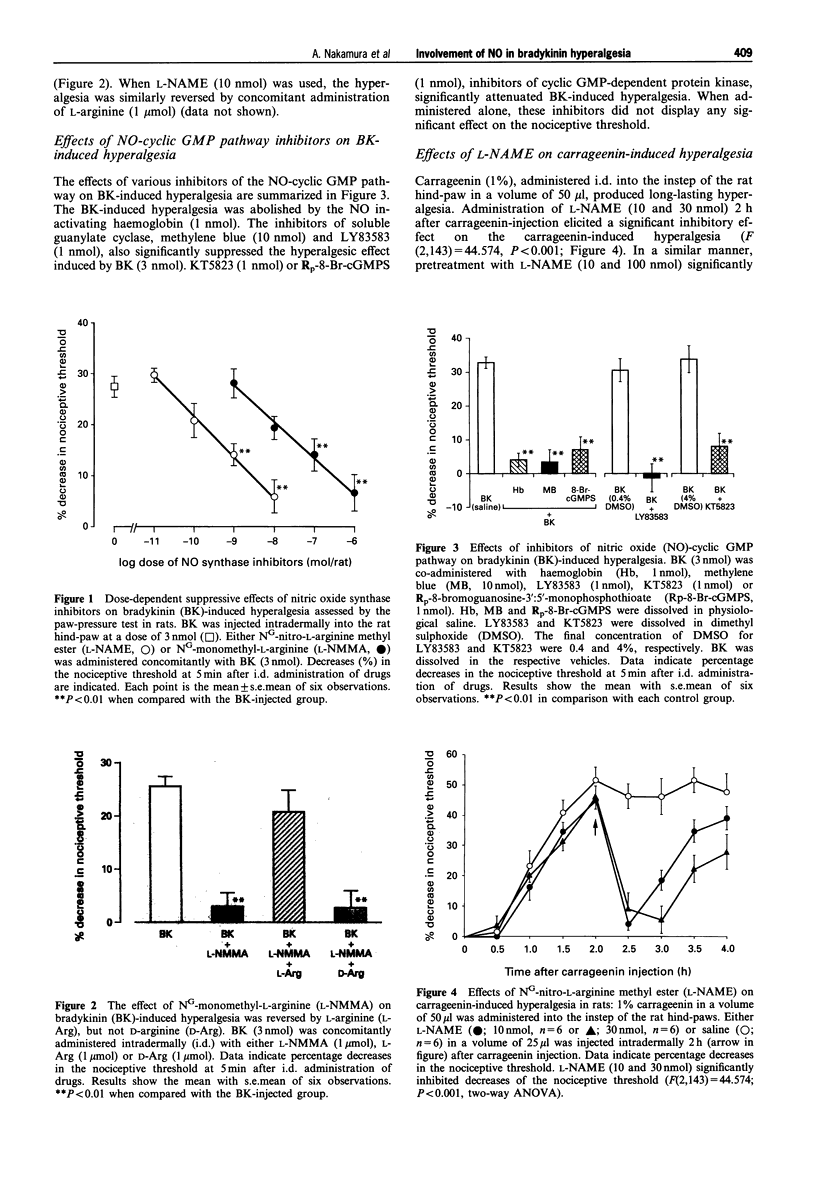
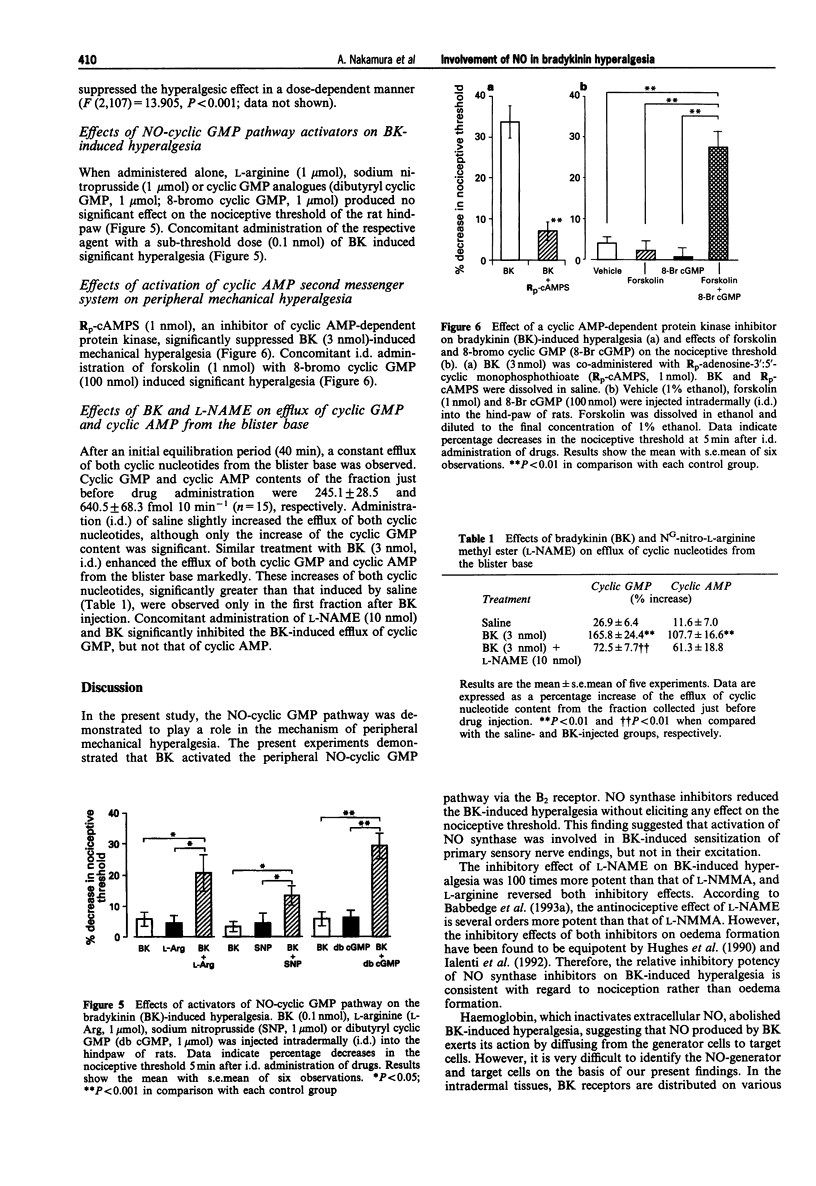
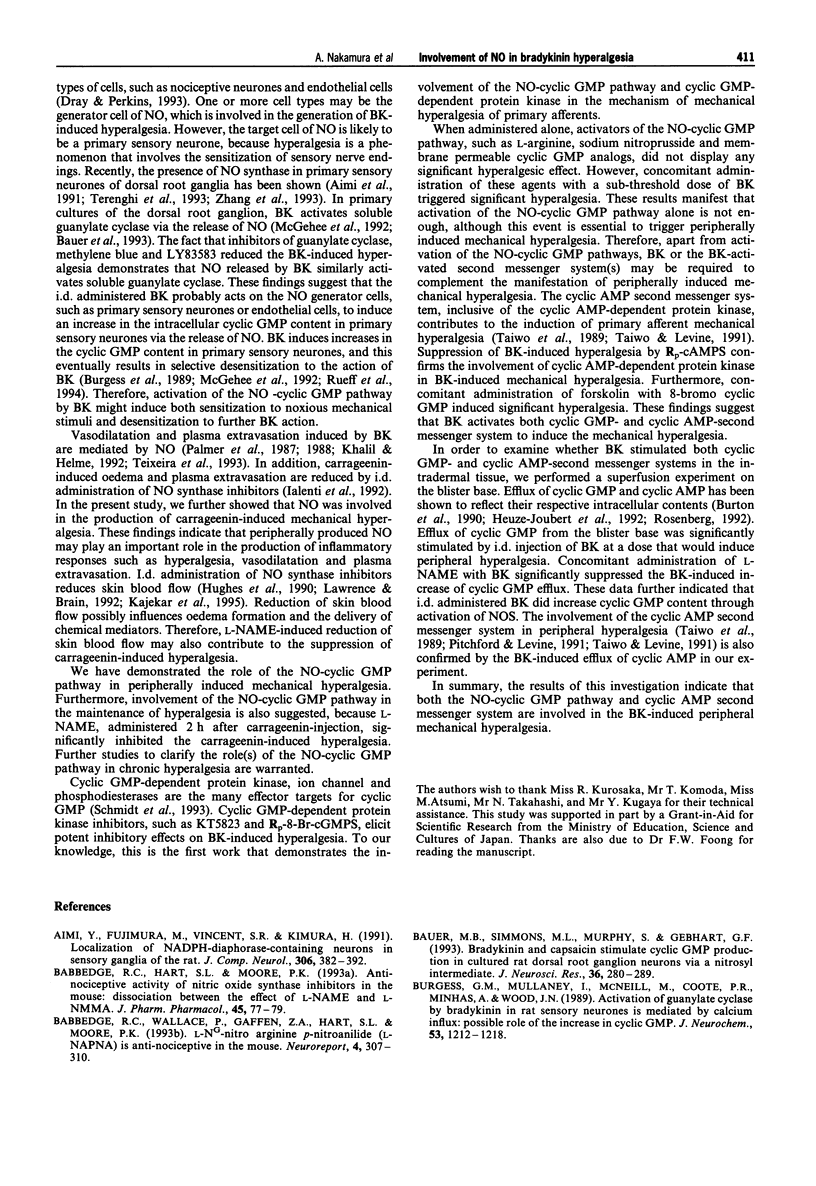
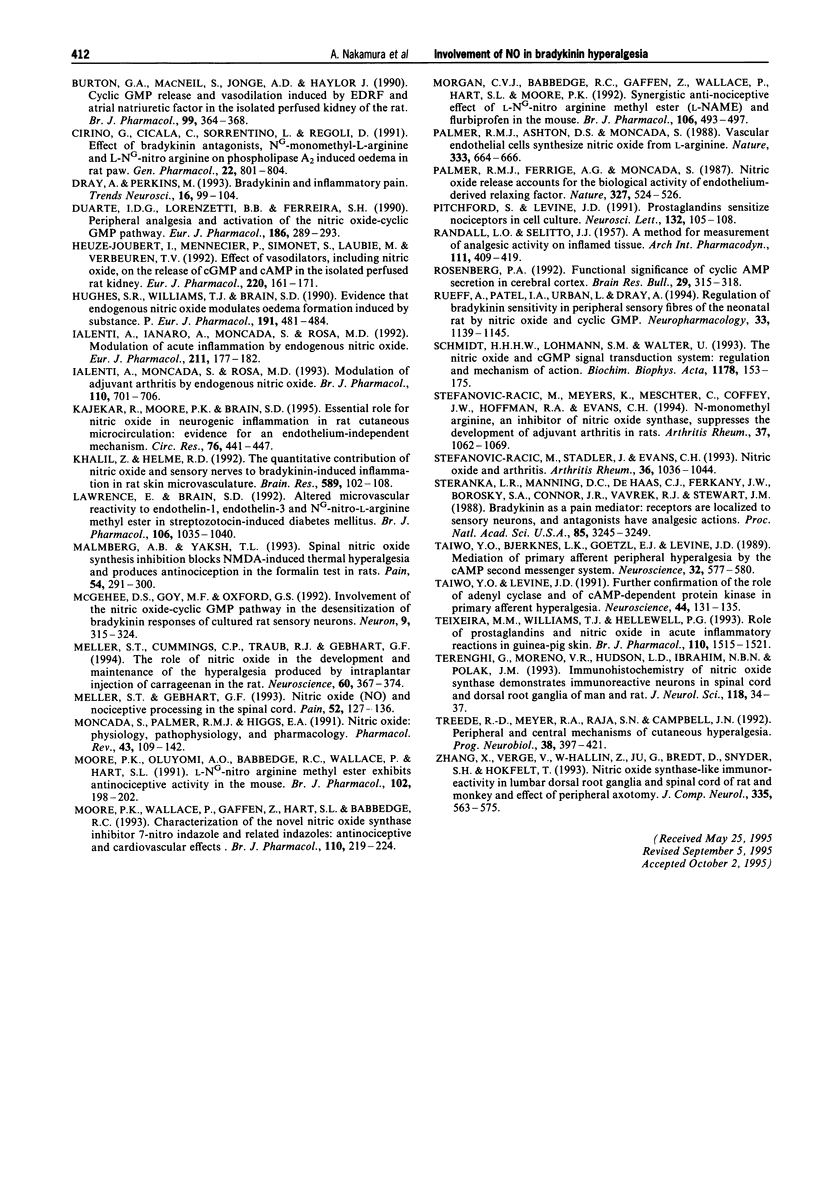
Selected References
These references are in PubMed. This may not be the complete list of references from this article.
- Aimi Y., Fujimura M., Vincent S. R., Kimura H. Localization of NADPH-diaphorase-containing neurons in sensory ganglia of the rat. J Comp Neurol. 1991 Apr 15;306(3):382–392. doi: 10.1002/cne.903060303. [DOI] [PubMed] [Google Scholar]
- Babbedge R. C., Hart S. L., Moore P. K. Anti-nociceptive activity of nitric oxide synthase inhibitors in the mouse: dissociation between the effect of L-NAME and L-NMMA. J Pharm Pharmacol. 1993 Jan;45(1):77–79. doi: 10.1111/j.2042-7158.1993.tb03686.x. [DOI] [PubMed] [Google Scholar]
- Babbedge R. C., Wallace P., Gaffen Z. A., Hart S. L., Moore P. K. L-NG-nitro arginine p-nitroanilide (L-NAPNA) is anti-nociceptive in the mouse. Neuroreport. 1993 Mar;4(3):307–310. doi: 10.1097/00001756-199303000-00020. [DOI] [PubMed] [Google Scholar]
- Bauer M. B., Simmons M. L., Murphy S., Gebhart G. F. Bradykinin and capsaicin stimulate cyclic GMP production in cultured rat dorsal root ganglion neurons via a nitrosyl intermediate. J Neurosci Res. 1993 Oct 15;36(3):280–289. doi: 10.1002/jnr.490360306. [DOI] [PubMed] [Google Scholar]
- Burgess G. M., Mullaney I., McNeill M., Coote P. R., Minhas A., Wood J. N. Activation of guanylate cyclase by bradykinin in rat sensory neurones is mediated by calcium influx: possible role of the increase in cyclic GMP. J Neurochem. 1989 Oct;53(4):1212–1218. doi: 10.1111/j.1471-4159.1989.tb07417.x. [DOI] [PubMed] [Google Scholar]
- Burton G. A., MacNeil S., de Jonge A., Haylor J. Cyclic GMP release and vasodilatation induced by EDRF and atrial natriuretic factor in the isolated perfused kidney of the rat. Br J Pharmacol. 1990 Feb;99(2):364–368. doi: 10.1111/j.1476-5381.1990.tb14709.x. [DOI] [PMC free article] [PubMed] [Google Scholar]
- Cirino G., Cicala C., Sorrentino L., Regoli D. Effect of bradykinin antagonists, NG-monomethyl-L-arginine and L-NG-nitro arginine on phospholipase A2 induced oedema in rat paw. Gen Pharmacol. 1991;22(5):801–804. doi: 10.1016/0306-3623(91)90209-o. [DOI] [PubMed] [Google Scholar]
- Dray A., Perkins M. Bradykinin and inflammatory pain. Trends Neurosci. 1993 Mar;16(3):99–104. doi: 10.1016/0166-2236(93)90133-7. [DOI] [PubMed] [Google Scholar]
- Durate I. D., Lorenzetti B. B., Ferreira S. H. Peripheral analgesia and activation of the nitric oxide-cyclic GMP pathway. Eur J Pharmacol. 1990 Sep 21;186(2-3):289–293. doi: 10.1016/0014-2999(90)90446-d. [DOI] [PubMed] [Google Scholar]
- Heuzé-Joubert I., Mennecier P., Simonet S., Laubie M., Verbeuren T. J. Effect of vasodilators, including nitric oxide, on the release of cGMP and cAMP in the isolated perfused rat kidney. Eur J Pharmacol. 1992 Sep 22;220(2-3):161–171. doi: 10.1016/0014-2999(92)90744-o. [DOI] [PubMed] [Google Scholar]
- Hughes S. R., Williams T. J., Brain S. D. Evidence that endogenous nitric oxide modulates oedema formation induced by substance P. Eur J Pharmacol. 1990 Dec 4;191(3):481–484. doi: 10.1016/0014-2999(90)94184-y. [DOI] [PubMed] [Google Scholar]
- Ialenti A., Ianaro A., Moncada S., Di Rosa M. Modulation of acute inflammation by endogenous nitric oxide. Eur J Pharmacol. 1992 Feb 11;211(2):177–182. doi: 10.1016/0014-2999(92)90526-a. [DOI] [PubMed] [Google Scholar]
- Ialenti A., Moncada S., Di Rosa M. Modulation of adjuvant arthritis by endogenous nitric oxide. Br J Pharmacol. 1993 Oct;110(2):701–706. doi: 10.1111/j.1476-5381.1993.tb13868.x. [DOI] [PMC free article] [PubMed] [Google Scholar]
- Kajekar R., Moore P. K., Brain S. D. Essential role for nitric oxide in neurogenic inflammation in rat cutaneous microcirculation. Evidence for an endothelium-independent mechanism. Circ Res. 1995 Mar;76(3):441–447. doi: 10.1161/01.res.76.3.441. [DOI] [PubMed] [Google Scholar]
- Khalil Z., Helme R. D. The quantitative contribution of nitric oxide and sensory nerves to bradykinin-induced inflammation in rat skin microvasculature. Brain Res. 1992 Aug 28;589(1):102–108. doi: 10.1016/0006-8993(92)91167-d. [DOI] [PubMed] [Google Scholar]
- Lawrence E., Brain S. D. Altered microvascular reactivity to endothelin-1, endothelin-3 and NG-nitro-L-arginine methyl ester in streptozotocin-induced diabetes mellitus. Br J Pharmacol. 1992 Aug;106(4):1035–1040. doi: 10.1111/j.1476-5381.1992.tb14452.x. [DOI] [PMC free article] [PubMed] [Google Scholar]
- Malmberg A. B., Yaksh T. L. Spinal nitric oxide synthesis inhibition blocks NMDA-induced thermal hyperalgesia and produces antinociception in the formalin test in rats. Pain. 1993 Sep;54(3):291–300. doi: 10.1016/0304-3959(93)90028-N. [DOI] [PubMed] [Google Scholar]
- McGehee D. S., Goy M. F., Oxford G. S. Involvement of the nitric oxide-cyclic GMP pathway in the desensitization of bradykinin responses of cultured rat sensory neurons. Neuron. 1992 Aug;9(2):315–324. doi: 10.1016/0896-6273(92)90170-i. [DOI] [PubMed] [Google Scholar]
- Meller S. T., Cummings C. P., Traub R. J., Gebhart G. F. The role of nitric oxide in the development and maintenance of the hyperalgesia produced by intraplantar injection of carrageenan in the rat. Neuroscience. 1994 May;60(2):367–374. doi: 10.1016/0306-4522(94)90250-x. [DOI] [PubMed] [Google Scholar]
- Meller S. T., Gebhart G. F. Nitric oxide (NO) and nociceptive processing in the spinal cord. Pain. 1993 Feb;52(2):127–136. doi: 10.1016/0304-3959(93)90124-8. [DOI] [PubMed] [Google Scholar]
- Moncada S., Palmer R. M., Higgs E. A. Nitric oxide: physiology, pathophysiology, and pharmacology. Pharmacol Rev. 1991 Jun;43(2):109–142. [PubMed] [Google Scholar]
- Moore P. K., Oluyomi A. O., Babbedge R. C., Wallace P., Hart S. L. L-NG-nitro arginine methyl ester exhibits antinociceptive activity in the mouse. Br J Pharmacol. 1991 Jan;102(1):198–202. doi: 10.1111/j.1476-5381.1991.tb12153.x. [DOI] [PMC free article] [PubMed] [Google Scholar]
- Moore P. K., Wallace P., Gaffen Z., Hart S. L., Babbedge R. C. Characterization of the novel nitric oxide synthase inhibitor 7-nitro indazole and related indazoles: antinociceptive and cardiovascular effects. Br J Pharmacol. 1993 Sep;110(1):219–224. doi: 10.1111/j.1476-5381.1993.tb13795.x. [DOI] [PMC free article] [PubMed] [Google Scholar]
- Morgan C. V., Babbedge R. C., Gaffen Z., Wallace P., Hart S. L., Moore P. K. Synergistic anti-nociceptive effect of L-NG-nitro arginine methyl ester (L-NAME) and flurbiprofen in the mouse. Br J Pharmacol. 1992 Jun;106(2):493–497. doi: 10.1111/j.1476-5381.1992.tb14362.x. [DOI] [PMC free article] [PubMed] [Google Scholar]
- Palmer R. M., Ashton D. S., Moncada S. Vascular endothelial cells synthesize nitric oxide from L-arginine. Nature. 1988 Jun 16;333(6174):664–666. doi: 10.1038/333664a0. [DOI] [PubMed] [Google Scholar]
- Palmer R. M., Ferrige A. G., Moncada S. Nitric oxide release accounts for the biological activity of endothelium-derived relaxing factor. Nature. 1987 Jun 11;327(6122):524–526. doi: 10.1038/327524a0. [DOI] [PubMed] [Google Scholar]
- Pitchford S., Levine J. D. Prostaglandins sensitize nociceptors in cell culture. Neurosci Lett. 1991 Oct 28;132(1):105–108. doi: 10.1016/0304-3940(91)90444-x. [DOI] [PubMed] [Google Scholar]
- RANDALL L. O., SELITTO J. J. A method for measurement of analgesic activity on inflamed tissue. Arch Int Pharmacodyn Ther. 1957 Sep 1;111(4):409–419. [PubMed] [Google Scholar]
- Rosenberg P. A. Functional significance of cyclic AMP secretion in cerebral cortex. Brain Res Bull. 1992 Sep-Oct;29(3-4):315–318. doi: 10.1016/0361-9230(92)90062-3. [DOI] [PubMed] [Google Scholar]
- Rueff A., Patel I. A., Urban L., Dray A. Regulation of bradykinin sensitivity in peripheral sensory fibres of the neonatal rat by nitric oxide and cyclic GMP. Neuropharmacology. 1994 Oct;33(10):1139–1145. doi: 10.1016/s0028-3908(05)80003-6. [DOI] [PubMed] [Google Scholar]
- Schmidt H. H., Lohmann S. M., Walter U. The nitric oxide and cGMP signal transduction system: regulation and mechanism of action. Biochim Biophys Acta. 1993 Aug 18;1178(2):153–175. doi: 10.1016/0167-4889(93)90006-b. [DOI] [PubMed] [Google Scholar]
- Stefanovic-Racic M., Meyers K., Meschter C., Coffey J. W., Hoffman R. A., Evans C. H. N-monomethyl arginine, an inhibitor of nitric oxide synthase, suppresses the development of adjuvant arthritis in rats. Arthritis Rheum. 1994 Jul;37(7):1062–1069. doi: 10.1002/art.1780370712. [DOI] [PubMed] [Google Scholar]
- Stefanovic-Racic M., Stadler J., Evans C. H. Nitric oxide and arthritis. Arthritis Rheum. 1993 Aug;36(8):1036–1044. doi: 10.1002/art.1780360803. [DOI] [PubMed] [Google Scholar]
- Steranka L. R., Manning D. C., DeHaas C. J., Ferkany J. W., Borosky S. A., Connor J. R., Vavrek R. J., Stewart J. M., Snyder S. H. Bradykinin as a pain mediator: receptors are localized to sensory neurons, and antagonists have analgesic actions. Proc Natl Acad Sci U S A. 1988 May;85(9):3245–3249. doi: 10.1073/pnas.85.9.3245. [DOI] [PMC free article] [PubMed] [Google Scholar]
- Taiwo Y. O., Bjerknes L. K., Goetzl E. J., Levine J. D. Mediation of primary afferent peripheral hyperalgesia by the cAMP second messenger system. Neuroscience. 1989;32(3):577–580. doi: 10.1016/0306-4522(89)90280-7. [DOI] [PubMed] [Google Scholar]
- Taiwo Y. O., Levine J. D. Further confirmation of the role of adenyl cyclase and of cAMP-dependent protein kinase in primary afferent hyperalgesia. Neuroscience. 1991;44(1):131–135. doi: 10.1016/0306-4522(91)90255-m. [DOI] [PubMed] [Google Scholar]
- Teixeira M. M., Williams T. J., Hellewell P. G. Role of prostaglandins and nitric oxide in acute inflammatory reactions in guinea-pig skin. Br J Pharmacol. 1993 Dec;110(4):1515–1521. doi: 10.1111/j.1476-5381.1993.tb13994.x. [DOI] [PMC free article] [PubMed] [Google Scholar]
- Terenghi G., Riveros-Moreno V., Hudson L. D., Ibrahim N. B., Polak J. M. Immunohistochemistry of nitric oxide synthase demonstrates immunoreactive neurons in spinal cord and dorsal root ganglia of man and rat. J Neurol Sci. 1993 Aug;118(1):34–37. doi: 10.1016/0022-510x(93)90242-q. [DOI] [PubMed] [Google Scholar]
- Treede R. D., Meyer R. A., Raja S. N., Campbell J. N. Peripheral and central mechanisms of cutaneous hyperalgesia. Prog Neurobiol. 1992;38(4):397–421. doi: 10.1016/0301-0082(92)90027-c. [DOI] [PubMed] [Google Scholar]
- Zhang X., Verge V., Wiesenfeld-Hallin Z., Ju G., Bredt D., Synder S. H., Hökfelt T. Nitric oxide synthase-like immunoreactivity in lumbar dorsal root ganglia and spinal cord of rat and monkey and effect of peripheral axotomy. J Comp Neurol. 1993 Sep 22;335(4):563–575. doi: 10.1002/cne.903350408. [DOI] [PubMed] [Google Scholar]


